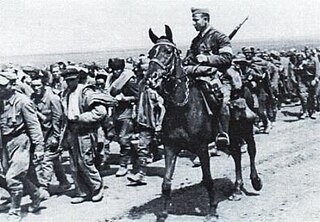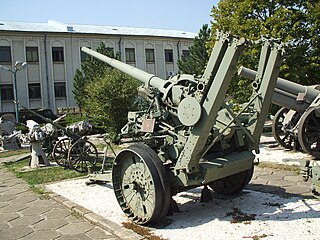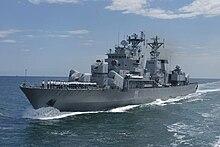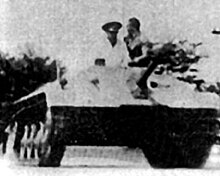The Kingdom of Romania, under the rule of King Carol II, was initially a neutral country in World War II. However, Fascist political forces, especially the Iron Guard, rose in popularity and power, urging an alliance with Nazi Germany and its allies. As the military fortunes of Romania's two main guarantors of territorial integrity—France and Britain—crumbled in the Fall of France, the government of Romania turned to Germany in hopes of a similar guarantee, unaware that Germany, in the supplementary protocol to the 1939 Molotov–Ribbentrop Pact, had already granted its blessing to Soviet claims on Romanian territory.

The IAR 79 was a twin-engine bomber and military reconnaissance aircraft with a wood and metal structure that saw service in World War II built under licence in Brasov, Romania, by Industria Aeronautică Română

The Cannone da 47/32 mod. 1935 was an Italian artillery piece that saw service during World War II. It was originally designed by Austrian firm Böhler, and produced in Italy under license. The Cannone da 47/32 was used both as an infantry gun and an anti-tank gun at which it was effective against light to medium armored tanks.

T-20 armored tractor Komsomolets(Bronirovannyy gusenichnyy tyagach Komsomolets T-20), an armored continuous track tractor, the T-20 was a prime mover vehicle used by the Soviet Union during the Winter War and World War II.

The Orița is a 9×19mm Parabellum submachine gun that was manufactured in Romania during World War II and for several years afterwards. It was named for Captain Marin Orița, who is credited in Romania with its design. The mass production was made by CMC Uzinele Metallurgice Copșa Mică together with Cugir Arms Factory. The first version, Model 1941, entered operational service with the Romanian Army in 1943. Two later improved models were the Model 1948, with a fixed wooden stock, and the rare paratrooper Model 1949, with a folding metal stock. It remained in service with the Romanian Army until it was replaced in the 1960s by the more powerful Pistol Mitralieră model 1963/1965, a Romanian version of the AK-47 assault rifle. The Orița remained in service with the Romanian paramilitaries until the 1970s.

The IAR 37 was a 1930s Romanian reconnaissance or light bomber aircraft built by Industria Aeronautică Română.

The TACAM R-2 was a Romanian tank destroyer used during World War II. It was built by removing the turret of the R-2 light tank and building a pedestal to mount a Soviet 76.2 mm (3.00 in) ZiS-3 field gun in its place. A three-sided fighting compartment was built to protect the gun and its crew. Twenty were built in 1944, but only one is known to exist today. It participated in the Budapest Offensive and the Prague Offensive.

The SET 7 was a military trainer and reconnaissance aircraft that was produced in Romania in the mid-1930s. It was originally designed as a conventional single-bay biplane, with slightly staggered wings, a standard undercarriage with fixed tailskid, and a tandem open-cockpit arrangement for the pilot and instructor or observer. Power was supplied by an Armstrong Siddeley Jaguar radial engine, and from the outset the aircraft was equipped for wireless and photographic reconnaissance duties.

Operation München was the Romanian codename of a joint German-Romanian offensive during the German invasion of the Soviet Union in World War II, with the primary objective of recapturing Bessarabia, Northern Bukovina and the Hertsa region, ceded by Romania to the Soviet Union a year before. The operation concluded successfully after 24 days of fighting. Axis formations involved included the Romanian Third and the Fourth Armies and the German Eleventh Army. The invasion was followed by a genocide against the Jewish population of Bessarabia.

The 75 mm Reșița Model 1943 was an anti-tank gun produced by Romania during World War II. It combined features from the Soviet ZiS-3 field/anti-tank gun, the German PaK 40 and the Romanian 75 mm Vickers/Reșița Model 1936 anti-aircraft gun. It saw service against both the Soviets during the Jassy-Kishniev Offensive and against the Germans during the Budapest Offensive and subsequent operations to clear Austria and Czechoslovakia.

The TACAM T-60 was a Romanian tank destroyer used during World War II. It was built by removing the turret of captured Soviet T-60 light tanks and building a pedestal to mount a captured Soviet 76.2 mm (3.00 in) M-1936 F-22 field gun in its place. A three-sided fighting compartment was built to protect the gun and its crew. Thirty-four were built in 1943, and they served in the Jassy-Kishniev Offensive, and the Budapest Offensive.

The Vickers Model 1931 was a British anti-aircraft gun used during the Second World War. The design was rejected by the British and Vickers exported the gun worldwide during the 1930s.

The TACAM R-1 was a small tank destroyer for use by Romania during World War II. It was designed on 22 November 1943 at the request of the Romanian General Staff. Fourteen R-1 vehicles were to be rearmed with 45 mm 20-K guns. Although this vehicle was designed to be used only for security duties, the project was cancelled because it was eventually regarded as a waste of badly needed industrial capacity, the 45 mm gun having been obsolete against most Soviet tanks by then.

The TACAM T-38 was a tank destroyer design proposed to be built in Romania during World War II. It was supposed to be a successor of the similar TACAM R-2, but never entered production.

The T-1 tractor was a project developed by the Romanian Army during World War II. A total of 1,000 were ordered. It was designed to tow a Romanian 75 mm gun. After five prototypes were produced, the project was canceled due to the lack of priority.
R-3 was a proposed Romanian tank design for use in World War II. It was basically a variant of the Czechoslovak S-II-c tank prototype, which was itself a variant of the Panzer 35(t) tank with pneumatic steering which was going to be built in Romania because of the repeated acquisition failures. Because of political reasons and the limited industrial capacities of both Škoda Works and the Romanian industry, the design never entered production.
Southern Transylvania was a region of the Kingdom of Romania between 1940 and 1944, during World War II. The region of Transylvania, belonging entirely to Romania when the war started in 1939, was split in 1940 between Romania and Hungary, with the latter taking Northern Transylvania in the aftermath of the Second Vienna Award.
During the Second World War, the Kingdom of Romania produced, converted or significantly improved a variety of armored fighting vehicles, ranging from licence-built unarmed artillery tractors to tank destroyers of an original design which ended up - according to some accounts - as inspiration for some German AFV.
In 1942, a medium tank was proposed to be produced by the Axis-aligned Kingdom of Romania. The reason behind the proposal was the lack of a Romanian-produced armored fighting vehicle capable of challenging enemy Soviet tanks on the Eastern Front, as well as the allied Nazi Germany not being capable of supplying Romania with considerable amounts of tanks. The vehicle never saw production.






























